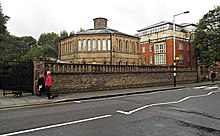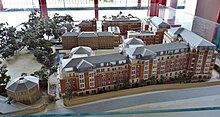Plymouth Marjon University
50°25′14″N 04°06′36″W / 50.42056°N 4.11000°W
 Coat of Arms | |
Other name | University of St Mark & St John |
|---|---|
Former names | University College Plymouth St Mark & St John (2007–2012) College of St Mark and St John (1923–2007) |
| Motto | Template:Lang-la |
Motto in English | Out of studies comes character |
| Type | Independent Church of England voluntary |
| Established | University status (2012) Joint College (1923) St John's (1840) St Marks (1841) |
| Affiliation | University of Exeter (1991-2013)[1] |
| Vice-Chancellor | Rob Warner |
| Students | 2,750 (2022/23)[2] |
| Undergraduates | 2,215 (2022/23)[2] |
| Postgraduates | 535 (2022/23)[2] |
| Location | , |
| Website | marjon |
 | |
Plymouth Marjon University, commonly referred to as Marjon, is the trading name of the University of St Mark and St John, a university based primarily on a single campus on the northern edge of Plymouth, Devon, United Kingdom. Formerly named University College Plymouth St Mark & St John, the institution was awarded full university status in 2013.[1]
The Vice-Chancellor of the university is Rob Warner who joined in March 2017.
History


The university's history dates back to the foundation by the National Society (now National Society for Promoting Religious Education) of the constituent London colleges of St John's College in Battersea, London (1840) and St Mark's College in Chelsea, London (1841).[3] The former chapel of St Mark's College, designed by Edward Blore is on the Fulham Road, Chelsea, and is now a private residence. [4]
St Mark's College was founded upon the beliefs of The Reverend Derwent Coleridge, son of the poet Samuel Taylor Coleridge, its first principal: that its primary purpose was to widen the educational horizons of its students. During the First World War, St Mark's College was requisitioned by the War Office to create the 2nd London General Hospital, a facility for the Royal Army Medical Corps to treat military casualties.[5]
St John's College was established by Sir James Kay-Shuttleworth, together with Edward Carleton Tufnell, as a teacher training institution.[6]
These colleges merged in 1923, establishing a single institution in Chelsea as the College of St Mark & St John. In 1973 came the move to Plymouth due to the college outgrowing the Chelsea campus.
In 1991 the college became affiliated to the University of Exeter, which accredited it to run undergraduate and postgraduate programmes leading to degree awards of the University of Exeter, and in 2007, gained University College status, as the University College Plymouth St Mark & St John. It was awarded full university status as Plymouth Marjon University in 2013.[1]
Campus


The university campus is located several miles north of Plymouth city centre, next to Derriford Hospital. Residential accommodation is provided, with all first-year students guaranteed a place. In 2013 a major investment programme in campus facilities was completed, with new sport and exercise science laboratories, extensive indoor and outdoor sports provision, a theatre, a media centre and a music studio.
Academic profile
| National rankings | |
|---|---|
| Complete (2025)[7] | 116 |
Notable alumni
- Sharon Berry, founder of the Storybook Dads charity[8]
- Bob Brunning, bass guitarist, founder member of Fleetwood Mac[9]
- Joy Carroll, inspiration for The Vicar of Dibley[10]
- Sir Lewis Casson, established the Actors' Association which became the British Actors' Equity Association.[11]
- Tim Dakin, former Bishop of Winchester
- Helen Glover, London 2012 Olympic gold medal-winning rower and 2013 World Championship Gold Medal winner
- Harry Greenway, former Conservative MP for Ealing North
- Philip Kingsford, in 1912 held the best-ever triple jump record by an English-born athlete[12]
- Ernest Millington, Labour MP for Chelmsford 1945–50, and was the last surviving member of the House of Commons elected during the Second World War (he died in 2009).
- Ron Pickering, athletics coach and BBC sports commentator
- Paul Potts, English tenor. Winner of ITV's Britain's Got Talent 2007
- Henry Rawlingson Carr, Nigerian educationalist and administrator.
- Andrew Salkey, author, activist, poet, film and documentary maker
- Sir Frederick Wall, secretary of the Football Association, responsible for the purchase of the first Wembley Stadium
- Ian Whybrow, children's author.
- Anthony Willis, Paralympic games silver high jump and gold pentathlon winner.[13]
See also
References
- ^ a b c "History". Plymouth Marjon University. Retrieved 21 July 2019.
- ^ a b c "Where do HE students study?". Higher Education Statistics Agency. Retrieved 23 September 2024.
- ^ "College of St Mark and St John" (PDF). Royal Borough of Kensington and Chelsea. Retrieved 21 July 2019.
- ^ Grant, Phoebe. "A historic former church in the heart of Chelsea". Town & Country.
- ^ "Second London General Hospital". Lost Hospitals of London. Retrieved 21 July 2019.
- ^ "Papers of Sir James Phillips Kay-Shuttleworth". Archives Hub. Retrieved 21 July 2019.
- ^ "Complete University Guide 2025". The Complete University Guide. 14 May 2024.
- ^ "Starting new chapters". The Herald. Local World. 16 September 2008. Archived from the original on 7 April 2014. Retrieved 3 April 2014.
- ^ Laing, Dave (28 October 2011). "Bob Brunning obituary". The Guardian. London.
- ^ "The real Vicar of Dibley gets her own TV role". The Daily Telegraph. London. Retrieved 8 March 2012.
- ^ "Spartacus Educational". Archived from the original on 20 May 2012. Retrieved 8 March 2012.
- ^ "SR Olympic Sports". Archived from the original on 18 April 2020. Retrieved 21 March 2012.
- ^ "Cover Story". Marjon Today. 6. 1999.
